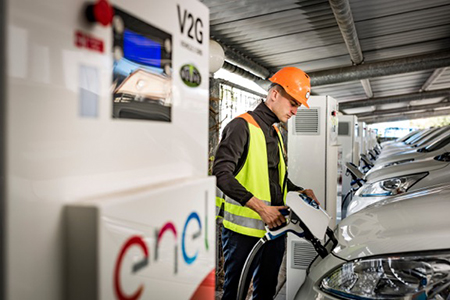
Nuvve and UC San Diego to Demonstrate Vehicle-to-Grid Technology Through Energy Commission Grant
Published Date
By:
- Laura Margoni
Share This:
Article Content

Nuvve will deploy its Vehicle to Grid charging platforms on 50 new UC San Diego electric vehicle chargers. The technology allows a parked electric vehicle to become part of an electric grid. Photo courtesy of Nuvve.
The United States is home to more than half a million electric vehicles. What if all those vehicles could be turned into virtual power plants, feeding energy back into the grid while connected via a charger? Thanks to a $4.2 million grant from the California Energy Commission, San Diego-based Nuvve Corporation will demonstrate how this technology could work on a large-scale with help from UC San Diego. Nuvve and its partners will provide additional funding to cover the $7.9 million total project cost.
Nuvve will deploy its “Vehicle to Grid” charging platforms on 50 new UC San Diego electric vehicle chargers. Vehicle to Grid technology allows a parked electric vehicle to become part of an electric grid – you can charge your vehicle at night, drive it to work in the morning and then charge the energy back into the grid when you park. Charging and discharging is flexible and based on real-time requests from the grid operator. Drivers would be paid every time the grid operator uses energy from their cars while still being guaranteed the expected level of charge needed to operate the vehicle.
“After successfully commercializing our services in Denmark, we are delighted to launch our NUVVEgives™ technology platform in California with the support of the California Energy Commission,” said Gregory Poilasne, Nuvve CEO. “We are going to tailor our platform to California’s specific needs and, with our partners, we will demonstrate the strong benefits generated by Vehicle to Grid technology.”
As part of the demonstration project, Nuvve will also use UC San Diego’s solar forecasting technology to inform its electric vehicle charging schedule. This technology includes weather models, machine learning tools and sky imagers – fish-eye lenses that capture a 360-degree view of the horizon and generate a 3-D model of the clouds they observe. The devices are connected to a sophisticated forecasting system that uses what it observes to predict solar power output in 15-minute increments.
“If the morning is cloudy, but the afternoon is forecast to be clear then charging will be delayed so that solar energy can be used directly,” explained Jan Kleissl, an environmental engineering professor at UC San Diego’s Jacobs School of Engineering who created the sky imagers and their algorithms. “Integrating solar forecasts into the charging schedule will allow Nuvve and the electric vehicle owner to make more informed decisions about when to charge or provide energy to the grid.”
Successful integration of Vehicle to Grid technology would benefit public organizations, businesses and homes by reducing the cost of electric infrastructure and reducing CO2 emissions.
“The return on this investment could extend far beyond San Diego and even California,” said Energy Commission Chair Robert B. Weisenmiller. “It provides a critical real-life demonstration of technology that can further incentivize clean transportation while also helping to provide a sustainable, reliable resource to the grid.”
The California Energy Commission grant is part of California’s Electric Program Investment Charge (EPIC) that provides grant funding for applied research and development, technology demonstration and deployment and market facilitation for clean energy technologies and approaches. The program is funded by ratepayers in the state’s three major investor-owned utilities.
Share This:
You May Also Like
Stay in the Know
Keep up with all the latest from UC San Diego. Subscribe to the newsletter today.


